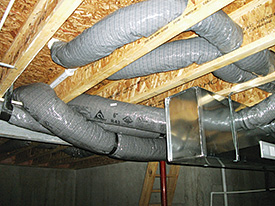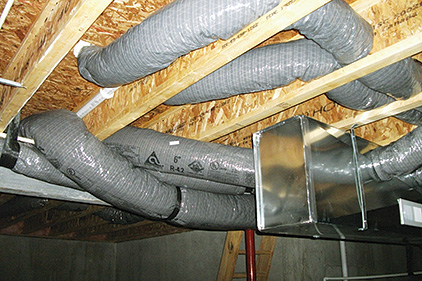A big step in the right direction for HVAC companies is the move toward proper design utilizing software. For decades, many have been using rules of thumb to size equipment and duct systems, making this upgrade a change in culture. These rules of thumb have typically been passed down through generations and are still considered to produce well-performing systems in many companies today; however, field testing proves otherwise.
Broken Thumbs

|
| How often does design equal reality in real-world conditions? Testing and verifying HVAC systems can help ensure system performance and efficiency. |
The revelation that many of these rules of thumb can get you into trouble, and also the need to comply with new code revisions, is accelerating the move toward using design software to meet industry standards.
The assumption that “a well-designed system automatically works” is also becoming more mainstream as software and recognized standards are being required by code. Install what the software says and everything will work properly, or will it?
The requirement for heat loss/gain calculations, equipment selection, and duct design calculations for code compliance are here to stay. This is allowing the trend of assuming performance to gain ground. It’s now easier than ever to assume your systems work simply because the software gives you more confidence than the previously used rules of thumb did.
If you give multiple system designers the identical house under identical design conditions, I find it curious that these professionals will often come up with a large variation in final results. Why is that? Shouldn’t all of their results be fairly close? If all were perfect, yes, they should come up with values that are fairly close in tolerance. The variance tends to be in the details, though.
Some of the load calculations I have seen presented to customers are works of art. Ten pages of full-color calculations and graphic illustrations are really impressive at first glance. It has to be credible if it looks that good, right? It’s not until you dig deeper that you might find issues hidden under the surface.
It begins with the information that is entered by the designer. The outcome of design software is dependent on user-entered information. If you enter bad information into the software, you get faulty final results. This isn’t the fault of the design software. The design software is limited by the information the designer feeds it. Yet, with all the possible errors that can be entered, all of the designers will swear they have the correct design calculations. Who is correct, and how could it be proven?
A Necessary Step
Proper system design is a necessary step when it comes to the adequate performance of an HVAC system. It is a beginning blueprint for everything else to build upon. If it is messed up, the next steps are all going to be off to some degree. This doesn’t minimize the importance of proper system design but helps everyone understand there are additional steps that need to be taken before the delivered system can operate well.
Proper system design was never intended to be a verification tool to determine whether a system is operating at its rated capacity. Unfortunately, this is what design software and standards writers are attempting to evolve into.
What About the Brakes?
Imagine that you take your car to a mechanic for some brake issues. Your car isn’t stopping as quickly as you know it should. The mechanic quickly pulls up the make and model of the car on his computer and proceeds to put in information about the brake system into his software program. He identifies that you indeed need new brakes and brake lines.
After agreeing to his quote, you allow him to perform the work on your car. He replaces the brakes and brake lines and reassembles all of the components of your car. He then hands you the keys and requests payment.
Sensing he may have missed something, you ask, “Aren’t you going to check those brakes to make sure they work properly?” The mechanic responds, “There’s no need in doing any of that, it’s just a waste of time. I designed your brake system with my design software. Everything will work just fine.”
How much faith would you have in your car to stop as you applied the brakes? Not much? I don’t blame you. What additional steps would you want your mechanic to take to ensure your car would actually stop when you applied the brakes? How about testing the brakes and verifying their real performance when it comes to stopping your car?
Making sure something works before it’s released to a customer is just good business. This may be easy to understand when looking at cars and brakes, yet it’s assumed on a daily basis by many when it comes to designing in the HVAC industry.
From Design to Reality
With so many assumptions taking place, is it any wonder there are so many from outside the HVAC industry coming in to test system installations as third-party verifiers? They are simply filling a void we have allowed to be created by not testing our own systems.
Isn’t it time to start ensuring the design of your HVAC systems is actually being achieved instead of assumed? Isn’t it time to start verifying the end result was truly accomplished? I hope you agree with me that the answer is a resounding yes. The time is now, but what steps need to be taken to ensure design equals reality?
In order to guarantee system design has been accomplished, it has to be verified, plain and simple. Airflow measurement, static pressure, duct losses, system temperature changes, and Btu calculations are the only way to verify the system is operating as designed.
Assuming the system operates as it should relying on design calculations is a habit that is going to come back to haunt those who rely on it. Heat loss/gain calculations, equipment selection procedures, and duct design calculations were never intended to guarantee performance. Shouldn’t we put the focus back where it was originally intended to be?
Publication date: 10/20/2014
Want more HVAC industry news and information? Join The NEWS on Facebook, Twitter, and LinkedIn today!



Report Abusive Comment